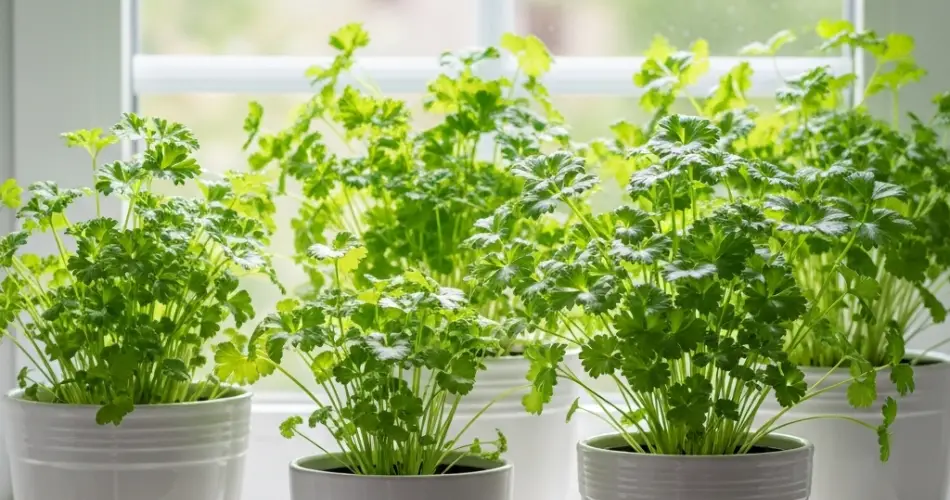Parsley is a versatile and nutrient-rich herb that’s easy to grow in pots at home. Whether you use it as a garnish, in sauces, or as a key ingredient in salads and soups, fresh parsley adds a bright, herbal flavor that dried parsley simply can’t match.
This guide will walk you through how to grow lush parsley in containers, from seed to harvest — perfect for kitchens, balconies, or patios.
Why Grow Parsley in Pots?
Container gardening makes it easy to control the growing environment, manage space, and keep herbs close to where you cook. Parsley grows well in pots and can thrive indoors or outdoors, as long as it gets the right care.
Benefits of growing parsley in containers include:
-
Convenience for harvesting.
-
Better soil control and fewer weeds.
-
Flexibility in placing the plant where it gets optimal sunlight.
-
Portability to bring the plant indoors during cold seasons.
Choosing a Variety
There are two main types of parsley:
-
Curly Leaf Parsley (Petroselinum crispum) – Known for its decorative, frilly leaves. Often used as a garnish.
-
Flat Leaf Parsley (Italian Parsley) – Has broader leaves and a stronger flavor, ideal for cooking.
Both types grow well in pots. Choose the variety that suits your culinary needs.
What You Need
Before you get started, gather the following materials:
-
A pot that is at least 8–10 inches deep with good drainage.
-
Potting mix rich in organic matter and well-draining.
-
Parsley seeds or seedlings.
-
Watering can or spray bottle.
-
A sunny spot with at least 4–6 hours of sunlight per day.
How to Plant Parsley in Pots
1. Prepare the Container
Fill your chosen pot with high-quality potting soil. Avoid using garden soil, as it can be too dense and may contain pests or diseases.
2. Sow the Seeds
Parsley seeds can be slow to germinate, often taking 2–3 weeks. To speed things up, soak the seeds overnight before planting.
-
Sow seeds about ¼ inch deep and lightly cover with soil.
-
Water gently to moisten the soil evenly.
If using seedlings, plant them about 6 inches apart.
3. Place in Sunlight
Parsley needs at least 4–6 hours of sunlight daily. A south-facing window or balcony is ideal. If you’re growing indoors and light is limited, consider using a grow light.
Watering and Care
-
Water consistently to keep the soil moist but not soggy. Parsley doesn’t like to dry out completely, especially during germination.
-
Avoid waterlogging, which can lead to root rot. Ensure the pot has drainage holes.
-
Fertilize lightly every 4–6 weeks with a balanced, water-soluble fertilizer or compost tea.
-
Remove any weeds or competing plants from the pot.
Tips for Lush Growth
-
Thin seedlings once they reach about 2 inches tall to allow air circulation and healthy development.
-
Regularly harvest the outer leaves, encouraging new growth from the center.
-
Pinch off any flower stalks that start to form, as flowering marks the end of the plant’s life cycle (parsley is a biennial).
-
During hot weather, move the plant to a slightly shaded area to prevent bolting.
Harvesting Your Parsley
You can begin harvesting parsley once the plant has a full rosette of leaves (usually 70–90 days after sowing).
-
Cut leaves from the outer part of the plant, using scissors or your fingers.
-
Always leave the inner stems and growing tip intact so the plant continues producing.
Frequent harvesting helps the plant stay productive and prevents it from becoming leggy or overgrown.
Common Issues and How to Avoid Them
Slow germination – Parsley is naturally slow to sprout. Soaking seeds helps. Keep the soil consistently moist during this stage.
Yellow leaves – May indicate overwatering, poor drainage, or lack of nutrients. Check your soil and drainage, and adjust watering frequency.
Leggy growth – Usually caused by inadequate sunlight. Move the pot to a sunnier location or supplement with artificial light.
Pests – Aphids or spider mites may occasionally appear. Rinse them off with water or use neem oil as a natural remedy.
Final Thoughts
Growing parsley in pots is a rewarding and practical way to ensure you always have a fresh supply of this essential herb. With just a little care, regular watering, and occasional feeding, you can enjoy a lush, vibrant parsley plant at home — right at your fingertips when you need it most in the kitchen.
Whether you have a large backyard, a compact balcony, or just a kitchen windowsill, parsley can thrive in pots and continue to grow throughout much of the year. Start with a few seeds or a healthy seedling, and in no time, you’ll be harvesting fresh parsley leaves whenever you cook.



